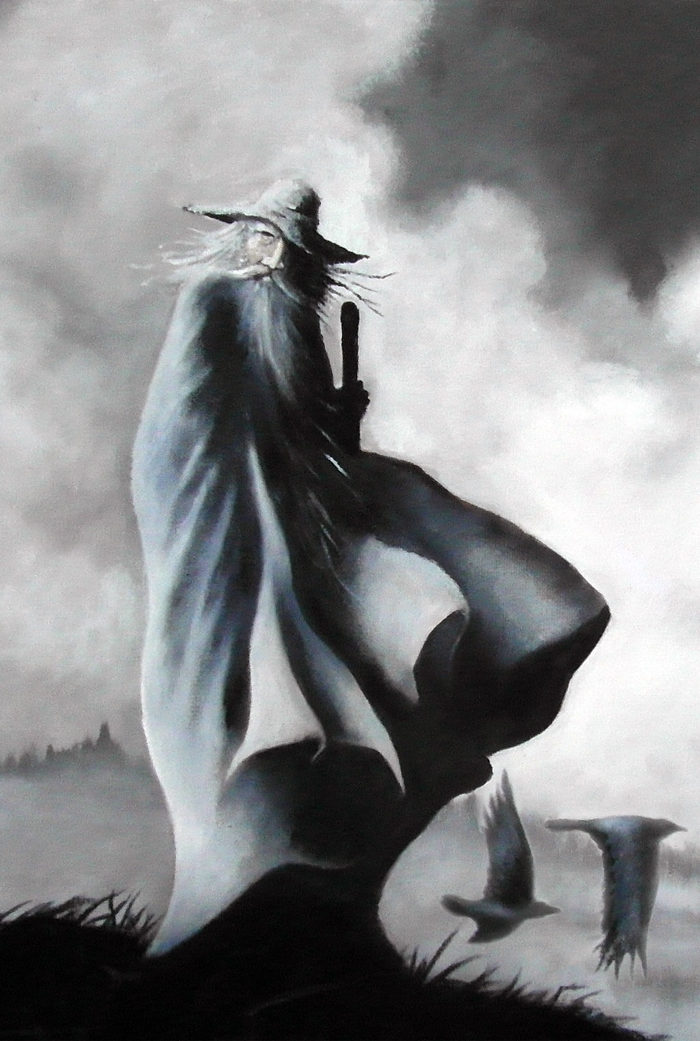
Odin the Wayfarer
The Gods are, of course, Spirit. As Spirit, they are real, living, intelligent, powerful beings, who, albeit ethereal and invisible to us, are ever-present. We depict them in images and icons, however, because when we raise our minds to the Gods in prayer and meditation, we inevitably translate our spiritual aspirations into human and physical terms, for we are human and physical beings. We do not, as Odinists, worship those images, since we are not 'idolators'; but the images are our attempt to translate spiritual truths into humanly comprehensible language.
This fascinating and haunting painting of 'Odin the Wayfarer' (by Yorkshire-born artist, Clive Barrett) depicts the God of wisdom, who travels the Nine Worlds to acquire insight and knowledge. He is said to send out his two ravens, Hugin (Thought) and Munin (Memory) every day to return at evening-time with the news they have gathered. The artist has skilfully conveyed the sense of mystery attached to the Allfather, and it makes us wonder, 'What is Odin thinking?', 'What purpose is he here undertaking?'
A prayer: 'Odin Allfather, Father of Gods and Men, you have shown us the merit of seeking wisdom. So inspire me that I may strive to gain knowledge and insight, and thus live my life wisely and honourably.'
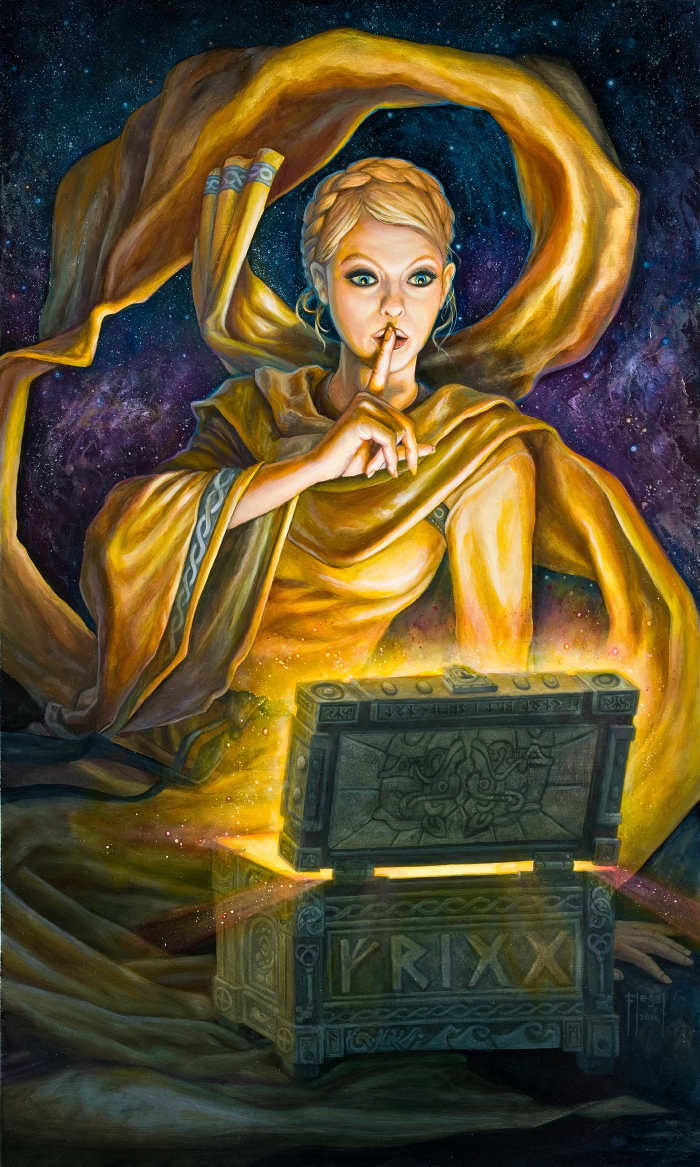
Frigg, Queen of Asgarth
We are very pleased to have in our Temple this beautiful oil painting by the well-known American illustrator and artist, Sam Flegal. It depicts Frigg, wife of Odin and queen of Asgarth, who is the patroness of home and family, wearing a gorgeous, golden robe, befitting her majesty.
It is said of Frigg, that she knows all, but does not reveal her secrets; and we are told in the Eddas that another Goddess, called Fulla, guards her shoes and her casket. Here Frigg is shown peering into the casket, her countenance illuminated by a numinous light emanating from within it, but what is it she sees inside?
A prayer: 'Holy Mother Frigg, consort of Odin, we hail you! Bless my home and my family and keep them safe from all danger and discord. This I ask for your honour's sake.'
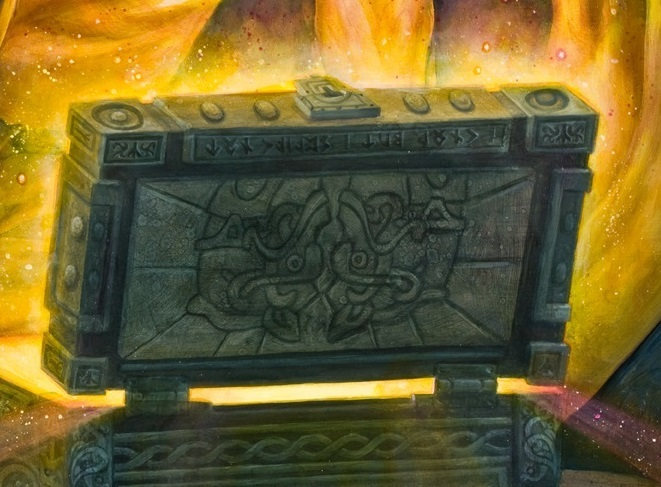
Runes on the Casket
Like all the artists who have contributed to this unique collection of Odinist paintings, Sam Flegal has drawn deep inspiration from the Northern myths and its lore. He has chosen to show, inscribed on the lid of Frigg's casket, a sentence in runes...
Frigg, who is depicted here holding a finger over her lips in the gesture of silence, knows much but rarely reveals her secrets. So what do you think the inscription says? I know, but I shan't say! (Just a clue to help you here: because the lid is open, the runes are obviously shown upside down.)
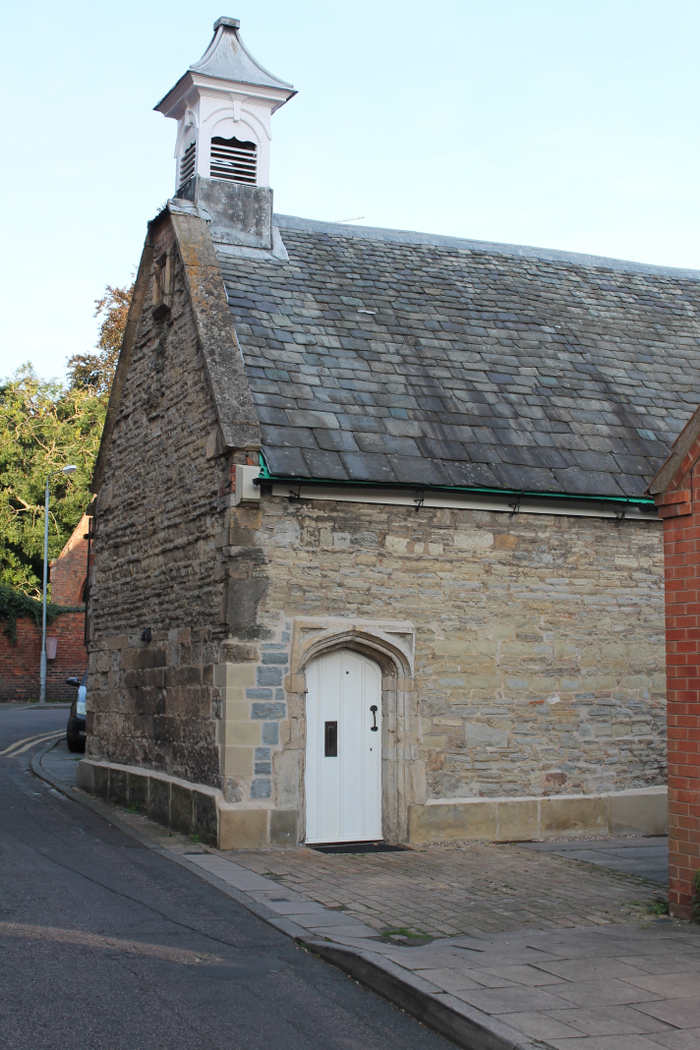
How to Get There
From Newark market square, standing with your back to the Town Hall, you will see a street leading out of the square towards the east, which is Bridge Street. At the end of this short street you will see a white building, housing Boyes, the hardware shop. There is a street running either side of Boyes. Take the street on the left-hand side of Boyes. This street is called Barnbygate. Passing by the Rutland Arms on your left, take the first turning from the left out of Barnbygate. This is Bede House Lane. You will immediately see the distinctive outline of the Temple about ten yards down on your right.
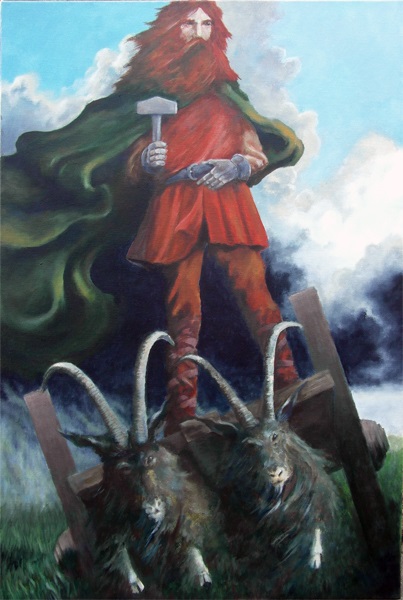
Thor, God of Thunder
Probably the best-known God of the North is Thor. Always depicted with a red beard (except by Marvel Comics – hardly an accurate source of information!), Thor is God of thunder and lightning. Here in this painting (by Clive Barrett) he is shown riding in his goat-drawn chariot through the storm clouds. He holds in his hand the fearsome Hammer, whose name is Miollnir (meaning 'Crusher' or 'Smasher'). Hot-tempered, but essentially good-natured, Thor has always been loved as the God who protects the common people.
A prayer: 'Endow us with strength, great Thor, in all the struggles and tribulations of our lives, and protect us from the the forces of chaos and the malevolence of ill-wishers.'
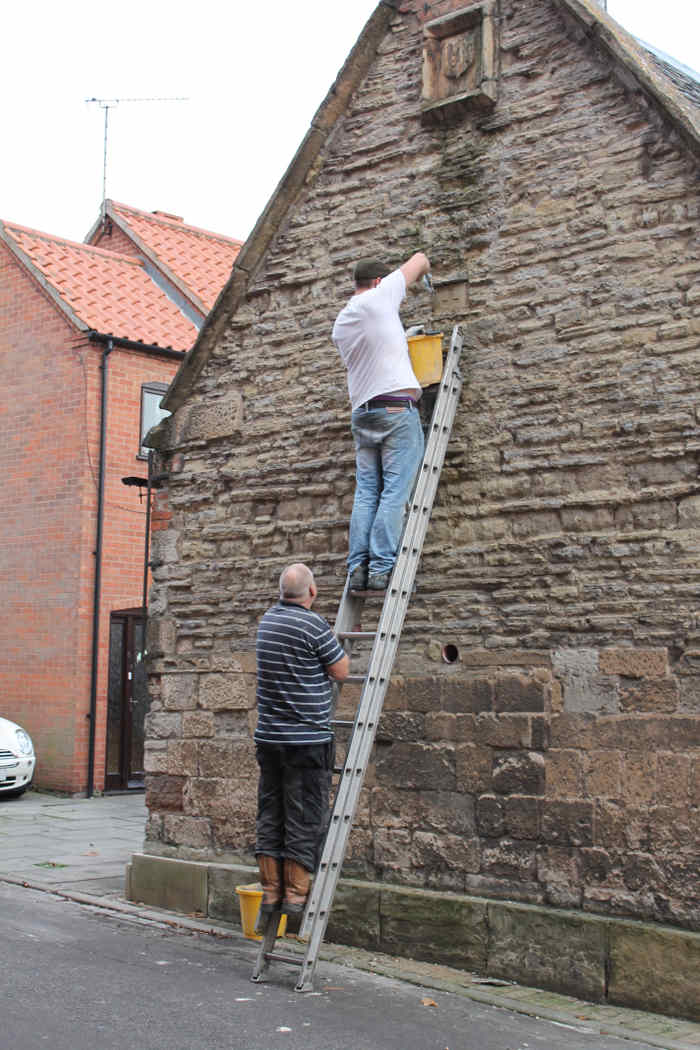
Thor's Hammer
The Thor's Hammer, in ancient times, was taken as the primary symbol of the faith. Although Thor used it to deal deathly blows to his foes, the giants, who represent, in the myths, the forces of cosmic chaos – in their eternal struggle with the forces of order and Nature – it can shrink to be so small as to be worn in one's shirt, so the Eddas tell us.
It always meets its mark, and afterwards it returns – wonderfully – to the hand of its thrower. Its origin was magical, and it was judged by the Gods from their judgment seats to be the most valued of all their possessions. And, yet, it has a fault! Its shaft was made too short.
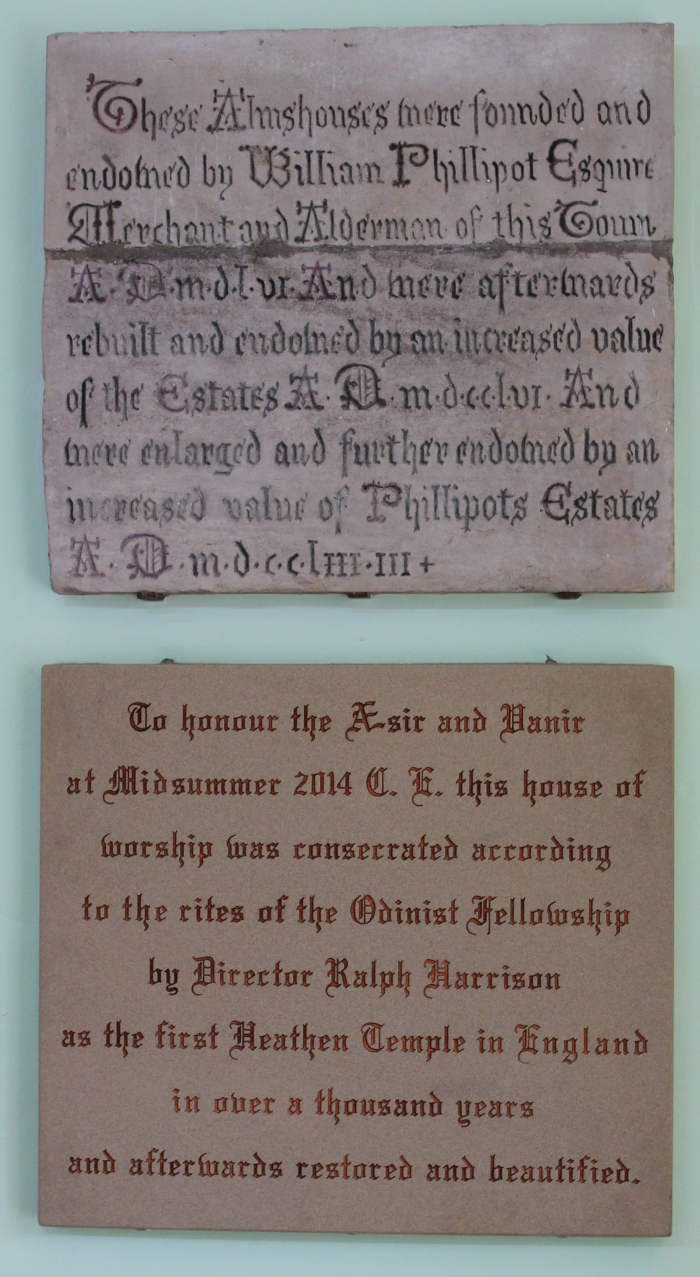
Historic Plaques
These two stone plaques tell something of the history of the Temple. The older, 18th Century plaque commemorates the foundation in 1556 of the house of worship and of the almshouses it served, and the other, its consecration in 2014 as the first heathen Temple in England in over a thousand years.
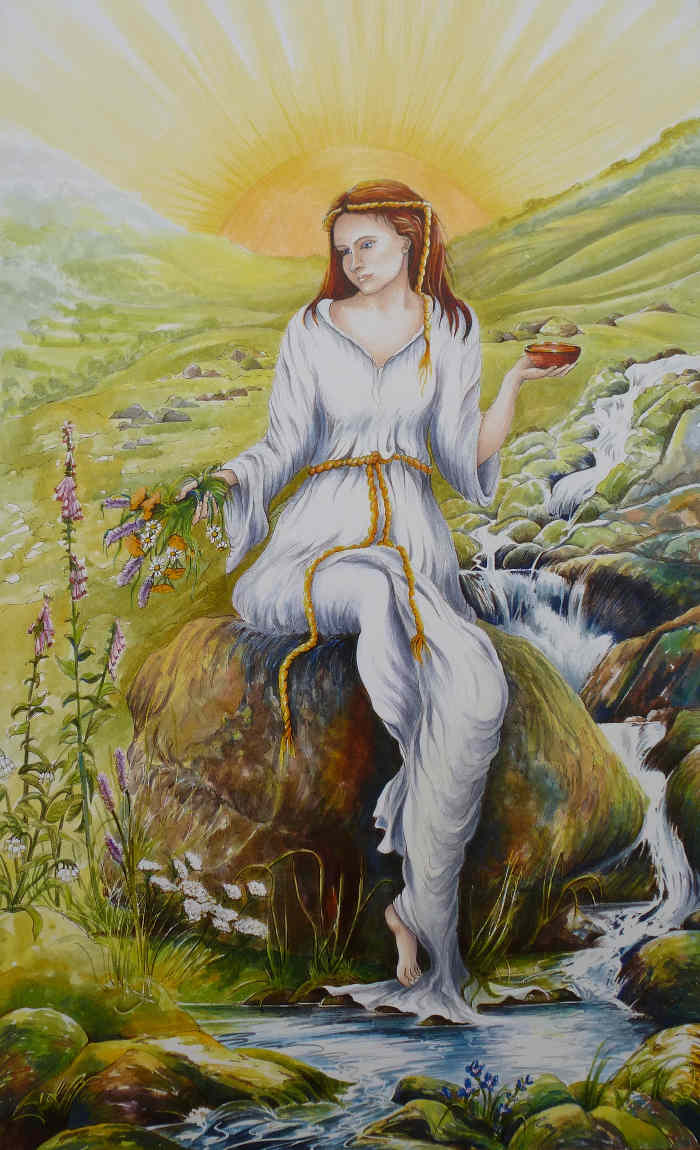
The Goddess of Healing
In any pagan religion the God or Goddess of healing is a deity of supreme importance. What is of more value than health and healing for oneself, one's loved ones – or even one's livestock? The Eddas inform us that the Northern Goddess of healing, Eir – her name rhymes with 'player' – is the best of all physicians. In this beautiful painting by Lincolnshire-based artist, Karen Devereux, we see Eir proffering health-giving herbs in one hand, and a bowl of water taken from a healing spring in the other.
Many people have prayed confidently to Eir for healing, either of themselves or of friends or family, and have reported remarkable improvements in health. Cures have been effected, and those who despaired of ever regaining their strength are well and happy again. She is a very powerful Goddess. Standing before her image to pray will help the petitioner envisage the Goddess more intensely. So it is hardly surprising that many pilgrims come to the Newark Odinist Temple for this reason alone.
To pray to Eir, simply meditate on her icon, saying: 'Eir, great Goddess of healing, whom men call the best of physicians, extend your health-giving power, and stretch out your hand to cure ........, and may all men and women praise you.' Or just say some simple, sincere prayer of your own instead.
We are all, of course, fated to die; so none can enjoy good health for ever; and even the Gods must submit to fate; but praying before the image of Eir has helped so many. Why should you not also ask for favours granted to others?
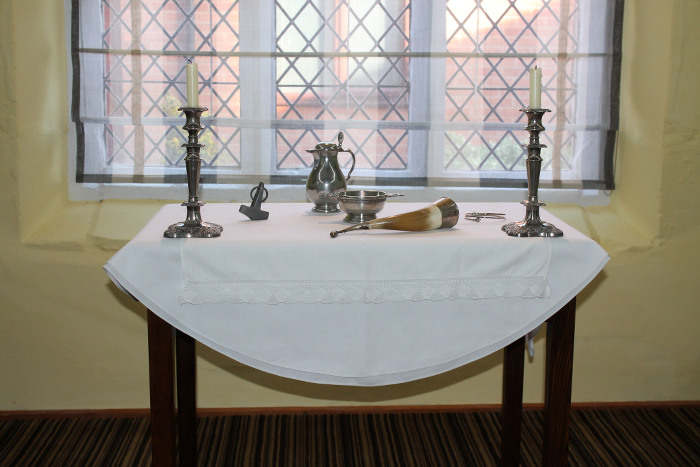
The Altar
Our altar is a simple table made of English oak. If you were to ask whether the Odinist Fellowship is 'high church' or 'low church' in its ritual, the answer would be 'moderation in all things!' Our ritual is intended to be transparent in meaning, but make no mistake: it possesses the magical power to achieve good!
The altar is sacred because on it is made the offering of mead. Mead, brewed from honey, is the oldest alcoholic beverage known to Man. In Odinic mythology it has symbolic associations with both sacrifice and inspiration. Mead is poured out into a sacred bowl during the rite of the Cup of Remembrance as a gift to the Gods, and then passed around in a drinking-horn among the faithful.
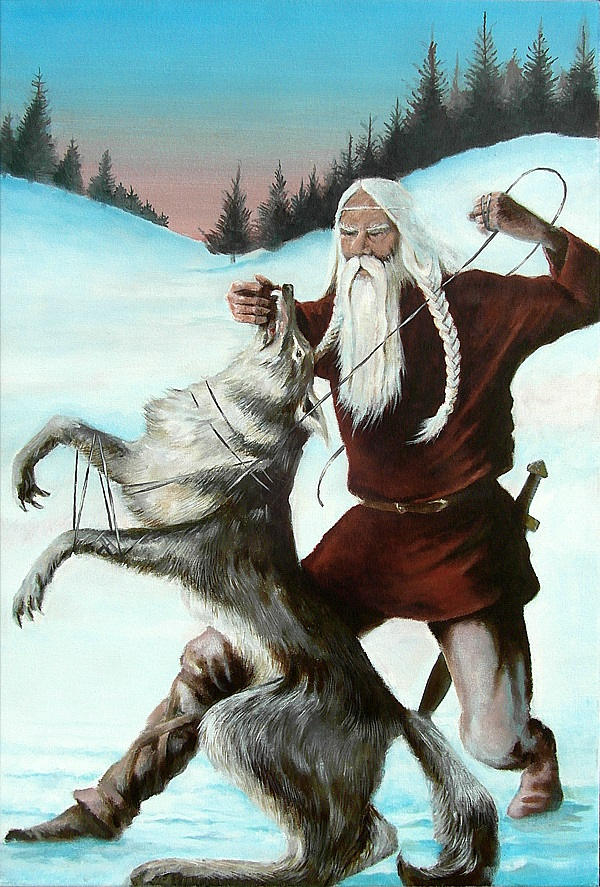
Tyr and Fenris Wolf
Fenris was the archetypal 'Big Bad Wolf', and he grew so large and threatening the Gods wanted to bind him. Tyr alone among the Gods was brave enough to place his hand in the wolf's mouth, so as to persuade it to test its strength against the magical fetter. That was how Tyr lost his sword-hand. Imagine that! To establish his position as God of war, Tyr first had to sacrifice his sword-hand. Our ancestors, who named one of the days of the week after Tyr, prayed to him for courage and victory in battle. Let us do the same.
A prayer: 'Tyr, God of valour and God of victory, watch over and defend our soldiers, sailors and airmen, those who fight overseas in our country's cause, and those who guard our homeland's shores from foreign invaders. Fill their hearts with courage in the fray, and bring them at last safely back home, crowned with victory and honour.'
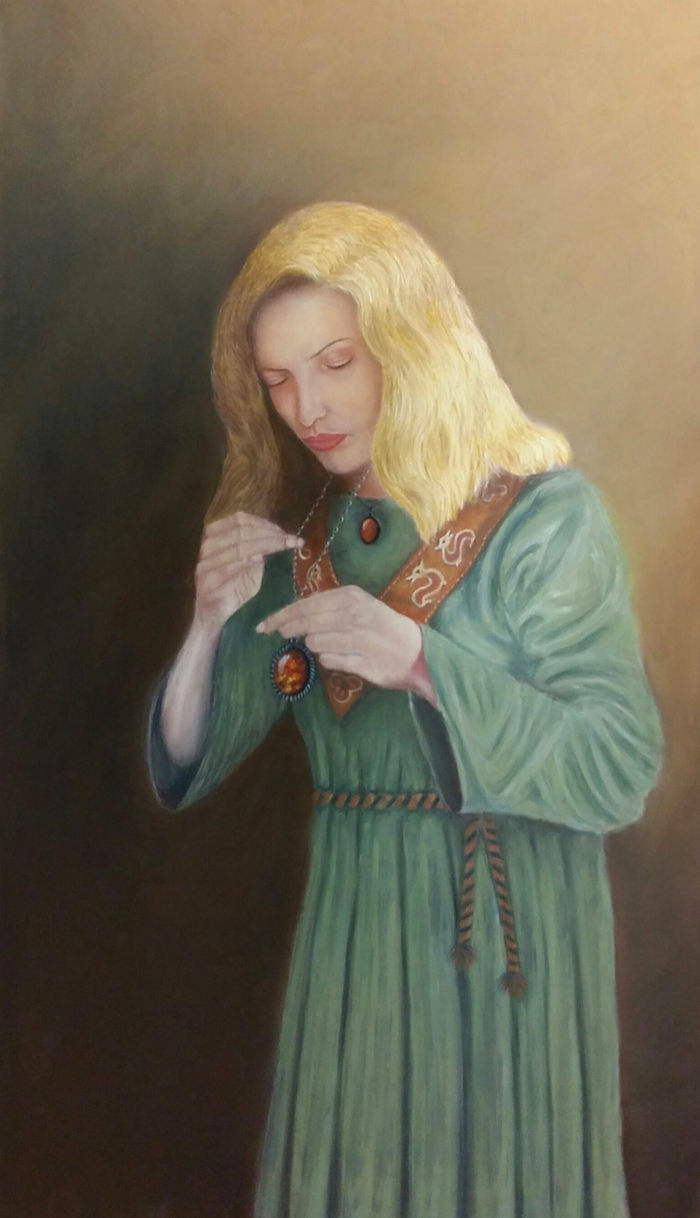
Freya, Goddess of Love
Freya and her brother, Frey, belong to that family of Gods known as the Vanir. Their concerns are fertility and the good things of the earth. In this painting by Newark-based artist, John Palmer, Freya, the Goddess of love and beauty, is shown in a wistful mood, gazing pensively at her famous Brisingamen necklace. Perhaps she is thinking longingly of her lost lover. The Eddas say it is good to pray to Freya in the affairs of the heart:-
'Gentle Freya, Lady of the Vanir, I thank you for the loveliness and grandeur of Nature and for the beauty of the world around us. May my life be not untouched by love, and grant, dear Goddess, my heart's true desire.'
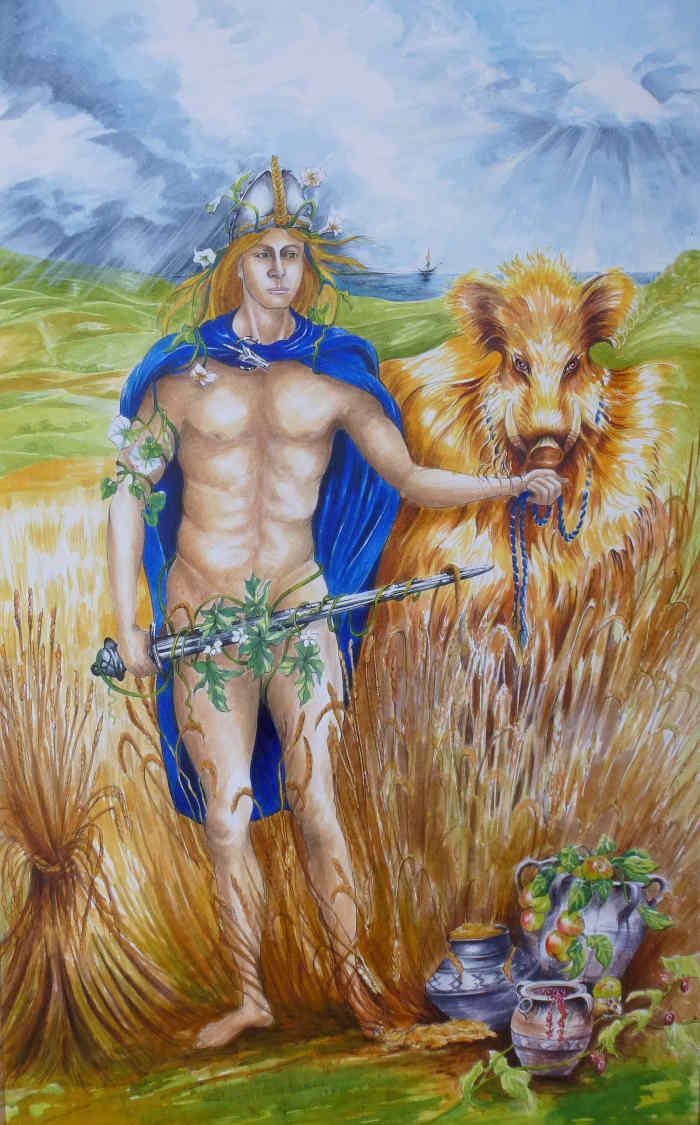
Frey, God of Plenty
In this painting by Karen Devereux is depicted one of the most powerful of all the Gods, Frey, Lord of the Vanir. Frey is God of peace and plenty, God of fertility and fruitfulness, God of rainfall and sunshine. So his importance, particularly in days of yore, when all depended for survival on the fruitfulness of the Earth, is self-evident. But we still depend on the Earth's fertility, don't we?
He is depicted with the golden boar forged as a gift by the dwarves, and in the background his ship, Skidbladnir, reminds us that Frey and the Vanir deities are concerned about the fruitfulness of the seas as well. Frey is also known as Ing, the eponymous God of the English, and the artist has shown Ing-runes inscribed around the edge of fruit-laden pottery at his feet. The sword he now wields in the painting, he is ultimately to yield in order to woo Gerd, the giantess's daughter, who represents the frozen Earth after winter. Here is a prayer:-
'Most generous of Gods, Frey, son of Niord, you are always free-giving to those who ask of you with a sincere heart. So grant me, I pray, all those things which are truly needful to me, both material and spiritual, and may my kindred prosper in the land and praise you.'
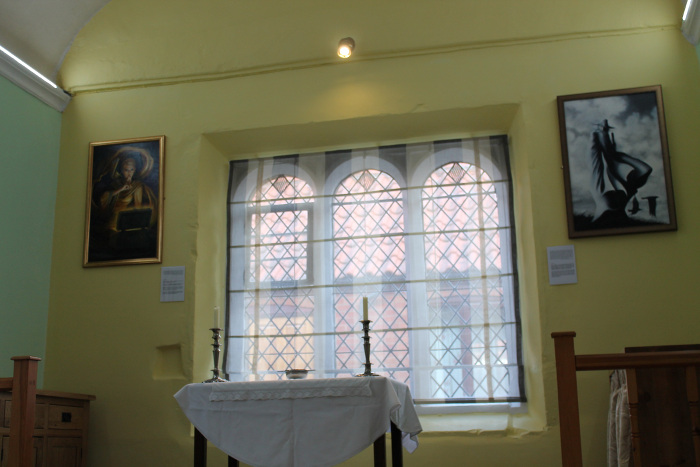
Many Other Gods
There are many other deities in the Odinic pantheon. Among the Gods there are Heimdall, Balder, Uller, Niord, Bragi, Vali, Vidar, Aegir, Forseti, Hoenir, Modi, Magni.
Among the Goddesses, we have Nanna, Idun, Sif, Saga, Skadi, Gefiun, Fulla, Gna, Siofn, Var, Vor, Iorth, Sol, Ostara, Rind, Snotra, Ran, Hlin, Syn, Lofn and the Norns, or Goddesses of fate, Urd, Verdandi and Skuld.
To have found space to present images of them all would require a much larger Temple – or else many more Temples!
Indeed, it has long been our aim to inaugurate a nationwide network of Odinist Temples to serve the growing Odinist community, and to provide a more accessible focus for the popular expression of the religion. The Gods have already helped us with so many 'lucky breaks', that we have no doubt at all that in due course we will achieve it. But we all have to start somewhere. And our 'Project of the Hundred Temples' has started here in Newark-on-Trent.
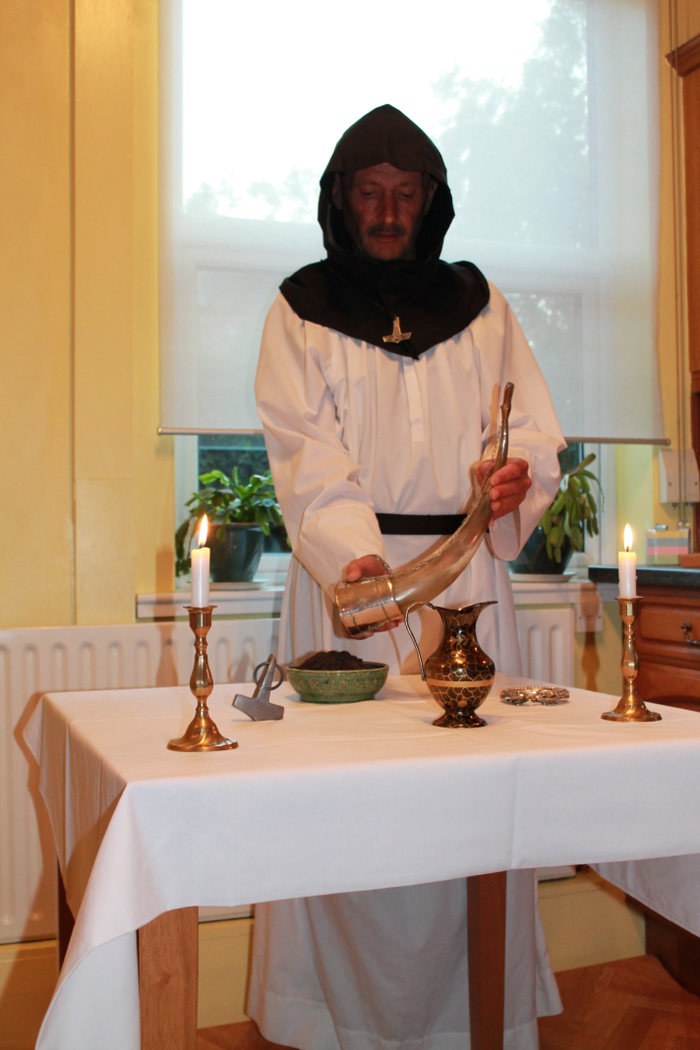
A Last Thought...
Many Odinists of course cannot regularly attend the Temple at Newark, if they live some distance away. This is, after all, our only Odinist Temple so far. So they must continue, perforce, to join together to worship and honour the Gods in their local house groups – or 'Hearths', as we call them. Those Hearths are Temples in embryo. I truly hope you have enjoyed this virtual tour of the Newark Odinist Temple. I hope even more that it will encourage you to visit it in person! (See the Events page for details of opening hours.)
No doubt many of you would like to know how you can help personally. Well, there are two main ways. One is to pray to the Gods and the Goddesses for the furtherance of the holy Odinist faith, England's true religion. The other way you can help is to give a donation, large or small. To do this, send a cheque or international money order, made out to 'Odinist Fellowship', and post it to us at:-
Odinist Fellowship, B.M. Edda, London WC1N 3XX, England. Thank you!